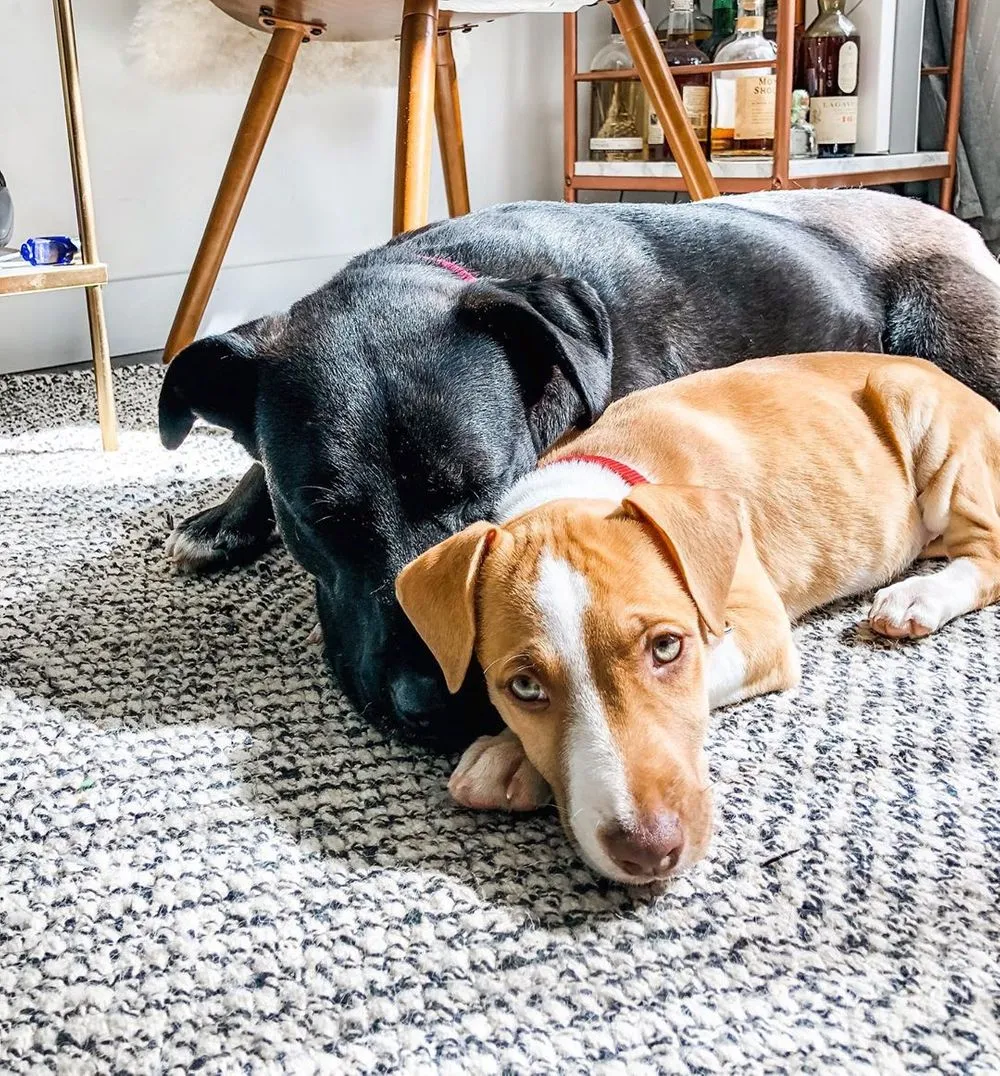Dogs are known for their unique ways of communicating with humans. One of the common behaviors exhibited by dogs is putting their paw on their owner's leg or arm. This behavior can be interpreted in different ways, depending on the context and the dog's personality.

Some dogs put their paw on their owner to get attention or affection. This is often a sign that the dog wants to be petted or played with. Other dogs may put their paw on their owner to communicate their needs, such as hunger or the need to go outside. In some cases, dogs may put their paw on their owner to show dominance or to assert their authority.
Understanding why dogs put their paw on their owner is important for building a strong and healthy relationship with them. By paying attention to their body language and context, owners can better understand what their dogs are trying to communicate. In the following section, we will explore the different reasons why dogs put their paw on their owner and how to respond to this behavior.
Understanding Dog Behavior

Dogs are known for their unique and complex communication methods, and pawing is one of them. Understanding the meaning behind a dog's pawing behavior can help owners better communicate with their pets and provide them with the necessary attention and care.
The Language of Paws
Pawing is a form of communication that dogs use to convey a variety of messages. According to the American Kennel Club, dogs may paw their owners to get attention, express affection, or seek comfort. They may also use their paws to show anxiety or stress.
Signs of Affection and Attention-Seeking
Dogs may paw their owners as a sign of affection or to seek attention. This behavior is often accompanied by tail wagging, licking, or other positive body language. Pawing can be a way for dogs to express their desire for interaction and playtime.
Indicators of Anxiety and Stress
On the other hand, pawing can also be a sign of anxiety or stress in dogs. When a dog is feeling anxious or stressed, they may paw their owners for comfort and reassurance. Pawing can also be a self-soothing mechanism for dogs, providing them with a sense of security and comfort.
It is important for dog owners to pay attention to their pet's body language and behavior to determine the underlying cause of their pawing behavior. Seeking the help of a professional dog behaviorist or veterinarian may be necessary in some cases.
Overall, understanding a dog's pawing behavior can help owners provide their pets with the necessary attention, affection, and care they need to live happy and healthy lives.
The Role of Pawing in Dog-Human Interaction

Building Trust and Bond
Dogs use their paws to communicate with humans in a number of ways. One of the most common reasons why dogs put their paws on their owners is to seek attention and affection. By pawing at their owners, dogs are attempting to establish a positive relationship with them. This can be seen as a sign of trust and love, as the dog is seeking the owner's attention and affection.
In addition to seeking attention, dogs may also use pawing as a way to reinforce positive behavior. When a dog is rewarded with attention or treats for pawing, they are more likely to repeat this behavior in the future. This can help to strengthen the bond between the dog and their owner, as the dog learns that positive reinforcement is associated with pawing.
Seeking Comfort and Reassurance
Another reason why dogs may put their paws on their owners is to seek comfort and reassurance. Dogs are social animals and often rely on their owners for emotional support. When a dog is feeling anxious or stressed, they may use pawing as a way to seek comfort from their owner.
In these situations, it is important for owners to respond with positive reinforcement. By providing comfort and reassurance to their dog, owners can help to strengthen the bond between them and their pet. This can help to build trust and create a positive relationship between the dog and their owner.
Overall, pawing is an important part of dog-human interaction. By understanding the role of pawing in their relationship with their dog, owners can build stronger bonds and create more positive relationships with their pets.
Common Reasons Dogs Put Their Paw on You

Dogs use their paws to communicate with their owners and other dogs. Here are some common reasons why dogs put their paw on you.
Requesting Food or Water
One of the most common reasons why dogs put their paw on you is to request food or water. If your dog is hungry or thirsty, he may use his paw to get your attention and let you know that he needs something to eat or drink. You may also notice that your dog puts his paw on his food bowl when he wants to be fed.
Invitation to Play or Go Outside
Another reason why dogs put their paw on you is to invite you to play or go outside. If your dog is feeling playful, he may use his paw to get your attention and encourage you to play with him. Similarly, if your dog needs to go outside, he may put his paw on you to let you know that he needs to go for a walk or to do his business.
Expressing Emotional Needs
Dogs also use their paws to express their emotional needs. For example, if your dog is feeling anxious or stressed, he may put his paw on you to seek comfort and affection. Dogs release oxytocin, the love hormone, when they are petted, which can help to reduce their stress levels and make them feel more relaxed. Additionally, some dogs may use their paws to show their affection and love for their owners.
Overall, dogs put their paw on their owners for a variety of reasons, including to request food or water, invite their owners to play or go outside, and express their emotional needs. By understanding why your dog is using his paw to communicate with you, you can better meet his needs and strengthen your bond with him.
Responding to Your Dog's Pawing

Dogs often use their paws to communicate with their owners, but it can be challenging to understand what they want. Here are some techniques to respond to your dog's pawing behavior.
Positive Reinforcement Techniques
Positive reinforcement techniques are one of the most effective ways to train your dog. When your dog paws at you, you can reward them with praise, treats, or toys to reinforce the behavior you want. This technique can help your dog understand that pawing is a good way to get your attention.
Setting Boundaries and Training Alternatives
It's essential to set boundaries with your dog to prevent unwanted pawing behavior. You can train your dog to sit or lie down when they want attention instead of pawing. You can also redirect their behavior by giving them a toy or treat to distract them from pawing.
Providing Comfort and Mental Stimulation
Dogs may paw at their owners when they are stressed or anxious. Providing a comfortable and stimulating environment can help reduce stress and prevent unwanted pawing. You can provide your dog with toys, puzzles, and games to keep them mentally stimulated. You can also create a calm and quiet space for your dog to relax.
In conclusion, responding to your dog's pawing behavior requires patience, training, and positive reinforcement. By setting boundaries, providing comfort, and training alternatives, you can prevent unwanted pawing behavior and create a healthy and happy relationship with your dog.
Health-Related Pawing Behaviors

Dogs may also paw their owners to communicate health-related issues. It is important for pet owners to be able to identify these behaviors to ensure their pets are healthy and comfortable.
Identifying Pain or Discomfort
One reason a dog may paw at their owner is to communicate pain or discomfort. Dogs may have underlying medical issues that cause them to feel uncomfortable or in pain, which they may try to communicate through pawing. Pet owners should observe their dog's behavior and look for other signs of discomfort, such as limping or decreased appetite. If a pet owner suspects their dog may be in pain or uncomfortable, they should consult with their veterinarian.
Recognizing Signs of Dominance or Submission
Dogs may also paw their owners as a sign of dominance or submission. Dominant dogs may paw at their owners to demand attention or assert their authority. Submissive dogs may paw at their owners as a way to show affection or to seek reassurance. Pet owners should observe their dog's body language and other behaviors to determine if their dog is exhibiting dominant or submissive behaviors.
In conclusion, pawing behaviors in dogs can be a way for them to communicate a variety of needs, including health-related issues. Pet owners should observe their dog's behavior and seek veterinary care if they suspect their dog may be in pain or uncomfortable. Understanding a dog's body language and behaviors can help pet owners provide the best care for their furry companions.
Enhancing the Human-Dog Relationship

Understanding Your Dog's Personality
Just like humans, dogs have unique personalities that influence their behavior and interactions with their owners. Understanding your dog's personality can help you build a stronger bond with your furry friend. Some dogs are more independent and may not seek as much attention or physical contact, while others are more affectionate and crave human touch. By observing your dog's body language and behavior, you can better understand their personality and tailor your interactions accordingly.
The Importance of Consistent Responses
Consistency is key when it comes to enhancing the human-dog relationship. Dogs thrive on routine and predictability, and inconsistent responses from their owners can lead to confusion and anxiety. For example, if your dog puts their paw on you and you sometimes respond with affection and other times push them away, your dog may become unsure of how to interact with you. It's important to establish clear boundaries and consistent responses to your dog's behavior to build trust and strengthen your relationship.
Consistent responses also play a crucial role in dog training. When teaching your dog new commands or behaviors, it's important to use the same cues and responses every time to avoid confusion. This helps your dog understand what is expected of them and reinforces positive behaviors. Consistency in training also helps to establish a strong bond between pet parents and their dogs.
In summary, enhancing the human-dog relationship requires understanding your dog's personality and providing consistent responses to their behavior. By building trust and affection through consistent interactions, pet parents can create a strong bond with their furry friends that lasts a lifetime.






